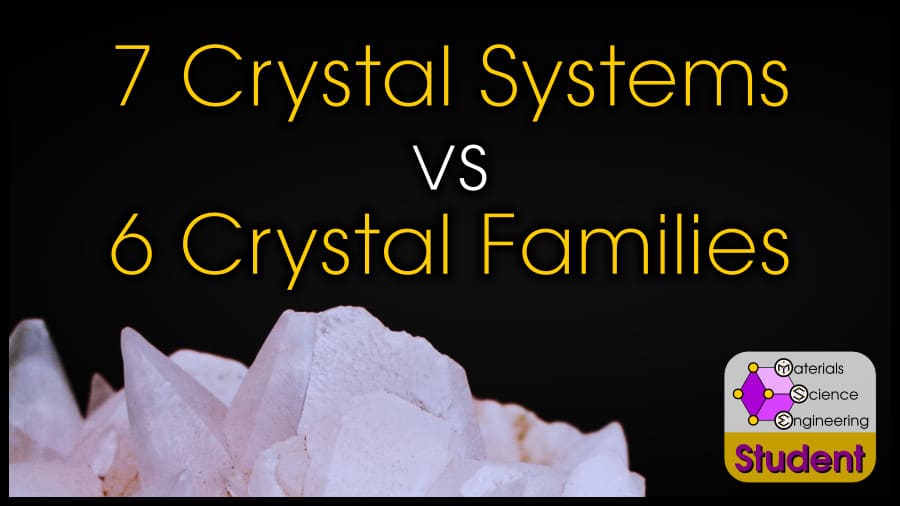
This is another of those articles that clarifies subtle terminology differences, plus a bonus chart that discusses the relationship between Bravais lattices, point groups, and space groups categorization.
What’s the difference between the terms “crystal system” and “crystal family?”
Crystal systems are determined by the underlying symmetry of point groups (rotation, reflection, inversion), while crystal families expand one family (hexagonal) to incorporate the underlying translational symmetry of lattice systems. In 3-dimensions, there are 7 crystal systems and 6 crystal families.
All rhombohedral crystals (lattice system) belong to the trigonal crystal system, but trigonal crystals may belong to the rhombohedral or to the hexagonal lattice system. Crystal families are defined such that any rhombohedral or trigonal crystal is part of the hexagonal crystal family.
Technically, the hexagonal crystal family encompasses any point group which has at least one associated space group that has a hexagonal lattice.
For example, there are four space groups which are generated from point group 3: space group P3, P31, P32, and R3. Of these four space groups, R3 has a rhombohedral lattice, but P3, P31, and P32 have hexagonal lattices. Since at least one of point group 3’s space groups has a hexagonal lattice, point group 3 belongs to the hexagonal crystal family.
| Point Group | Associated Space Groups (H-M Notation) | Associated Space Groups (Number) |
The 6 3-dimensional crystal families are:
- Cubic
- Hexagonal
- Tetragonal
- Orthorhombic
- Monoclinic
- Triclinic
This may seem very similar to the Bravais lattice systems
- Cubic,
- Hexagonal
- Rhombohedral
- Tetragonal
- Orthorhombic
- Monoclinic
- Triclinic
or the point group crystal systems
- Cubic,
- Hexagonal
- Trigonal
- Tetragonal
- Orthorhombic
- Monoclinic
- Triclinic
except both of these systems have an additional 7th category. (Note that the trigonal point group system and rhombohedral lattice system are not exactly related).
The crystal families are an attempt to combine the 7 lattice systems and 7 point group systems, by integrating the rhombohedral lattice system and trigonal point group system into the existing hexagonal crystal family.
This handy chart, inspired by the Practical Electron Microscopy and Database, illustrates this relationship between crystal family, crystal system, and lattice system.
| Crystal Family (6) | Number of Space Groups | Crystal System (7) | Number of Point Groups | Lattice System | Number of Bravais Lattices |
| Triclinic | 2 | Triclinic | 2 | Triclinic | 1 |
| Monoclinic | 13 | Monoclinic | 3 | Monoclinic | 2 |
| Orthorhombic | 59 | Orthorhombic | 3 | Orthorhombic | 4 |
| Tetragonal | 68 | Tetragonal | 7 | Tetragonal | 2 |
| Hexagonal | 7 | Trigonal | 5 | Rhombohedral | 1 |
| Hexagonal | 18 | Trigonal | 5 | Hexagonal | 1 |
| Hexagonal | 27 | Hexagonal | 7 | Hexagonal | 1 |
| Cubic | 36 | Cubic | 5 | Cubic | 3 |
In some sense, it is a coincidence that crystal systems and lattice systems line up so well, because they each have different symmetry definitions.
| Crystal System | Essential Symmetry of Crystal System | Crystal Family | Essential Symmetry of Lattice System | Lattice System |
| Triclinic | No axes of symmetry | Triclinic | a≠b≠c; α≠β≠γ | Triclinic |
| Monoclinic | 2-fold axis | Monoclinic | a≠b≠c; α=γ=90°≠β | Monoclinic |
| Orthorhombic | Three mutually perpendicular 2-fold axis | Orthorhombic | a≠b≠c; α=β=γ=90° | Orthorhombic |
| Tetragonal | 4-fold axis | Tetragonal | a=b≠c; α=β=γ=90° | Tetragonal |
| Trigonal | 3-fold axis | Hexagonal | a=b=c; α=β=γ<120° | Rhombohedral |
| a=b≠c; α=β=90°, γ=120° | Hexagonal | |||
| Hexagonal | 6-fold axis | |||
| Cubic | Four 3-fold axis | Cubic | a=b=c; α=β=γ=90° | Cubic |
Final Thoughts
At the end of the day, crystal family, crystal system, and lattice system are mostly interchangeable. They have only a few categories different–the hexagonal crystal family splits into hexagonal + trigonal crystal systems, or hexagonal + rhombohedral lattice systems, which comes from the symmetry approach used to create these categories.
You can think of “crystal families” as a simplification/unification of crystal systems and lattice systems.
References and Further Reading
Check out my full explanation of crystal systems if you want a more comprehensive look at them.
If you want to see the other crystallography-related articles I’ve written, here is this list, in recommended reading order:
Introduction to Bravais Lattices
What is the Difference Between “Crystal Structure” and “Bravais Lattice”
Atomic Packing Factor
How to Read Miller Indices
How to Read Hexagonal Miller-Bravais Indices
Close-Packed Crystals and Stacking Order
Interstitial Sites
Primitive Cells
How to Read Crystallography Notation
What are Point Groups
List of Point Groups
What are Space Groups
List of Space Groups
The 7 Crystal Systems
If you are interested in more details about any specific crystal structure, I have written individual articles about simple crystal structures which correspond to each of the 14 Bravais lattices:
1. Simple Cubic
2. Face-Centered Cubic
2a. Diamond Cubic
3. Body-Centered Cubic
4. Simple Hexagonal
4a. Hexagonal Close-Packed
4b. Double Hexagonal Close-Packed (La-type)
5. Rhombohedral
5a. Rhombohedral Close-Packed (Sm-type)
6. Simple Tetragonal
7. Body-Centered Tetragonal
7a. Diamond Tetragonal (White Tin)
8. Simple Orthorhombic
9. Base-Centered Orthorhombic
10. Face-Centered Orthorhombic
11. Body-Centered Orthorhombic
12. Simple Monoclinic
13. Base-Centered Monoclinic
14. Triclinic
